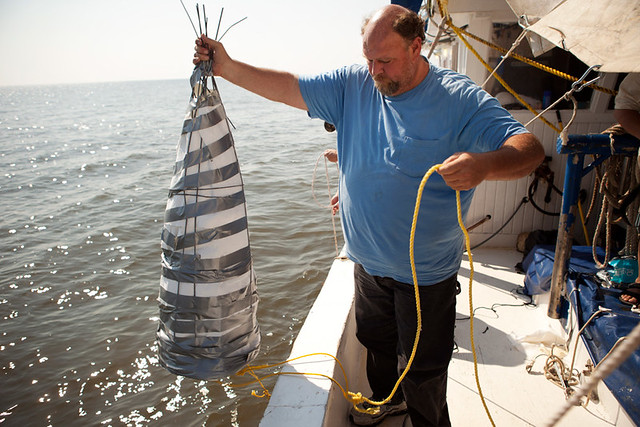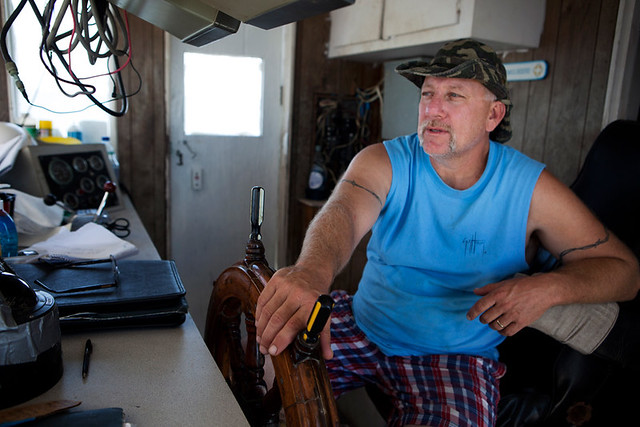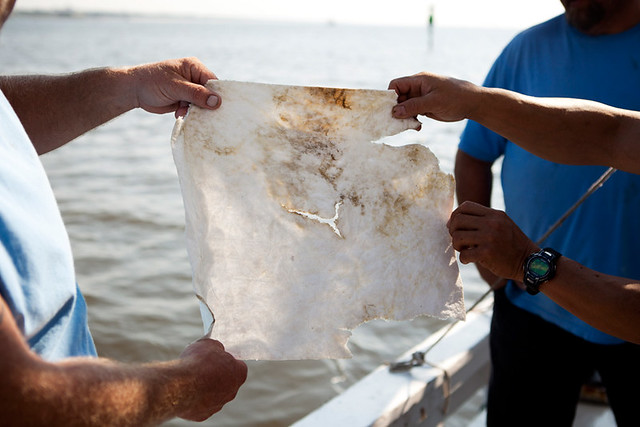SHRIMPERS IN MISSISSIPPI CONVINCED SEAWATER TAINTED DESPITE OFFICIAL CLEAN BILL OF HEALTH
I wanted to share this blog entry from the Expedition Blue Planet team. I was fortunate to spend some time with them on the boat with "Catfish", Danny and Mark.
bp
Coordinates: 30.17° N 89.15°W, Watershed: Mississippi Sound

(Mississippi shrimper Mark Stewart holds a makeshift oil testing tool lined with oil absorbent pads. Oscar Durand/Expedition Blue Planet)
“I just know that something’s different with my water,” says Edward “Danny” Ross Jr., a 7th generation shrimper from Ocean Springs, Mississippi.
As of August 6th, the official word is that the water is safe to swim in and eat from but this runs contrary to what Danny and his peers see in their waters every day: sorbent pads that come out of the water stained yellow and brown with what they believe to be a mix of oil and dispersants.
Danny believes that officials reopened the area to shrimping prematurely and are turning a blind eye to the mix of oil and dispersants that remains in Mississippi’s waters, taking its time to sink to the ocean floor: “It’s really going to hurt our feelings because it’s all food down there.”
James “Catfish” Miller took the Expedition Blue Planet crew out on his boat the Captain Quintinn to trawl the waters for oil – not the shrimp that this circa 1956 Biloxi Lugger style shrimp boat was built to find.
Mark Stewart, a third-generation fisherman has come too: “It’s about all we got to do; we don’t got no shrimp or oysters to catch.”
Officials report that algae blooms are responsible for the gunk in the water but the shrimpers remain unconvinced. “They say the oil is gone. We disagree,” Stewart tells an audience in a youtube clip.
“I guess you could call us The Disgruntled Fishermen’s Movement or the Mississippi Gulf Plume Association,” Danny says of the men on board, tongue in cheek.
We leave Pier C2 of Port Pass Christian Harbour and head out towards the Bay St. Louis bridge, staying about ¼ of a mile offshore from Wavelind beach.
It doesn’t take long for Catfish to leap to life from the captain’s chair, his pointed finger taut like an arrow, his barrel chest curved like a bow. “See that sheen line? I’m going to follow it to the source,” he says. “It’s just like a little game.”
 (Captain Catfish Miller at the helm of his boat Captain Quinntinn. Oscar Durand/Expedition Blue Planet)
(Captain Catfish Miller at the helm of his boat Captain Quinntinn. Oscar Durand/Expedition Blue Planet)
Last time Catfish followed a sheen line, every sample of oil absorbing paper he put down came up positive. “It was crazy,” he recalls.
Our hosts used to work on the Vessels of Opportunity, the BP-sponsored oil-clean up boats. This experience gave them the know-how to test for oil on their own.
Their methods are DIY but effective. Their oil plume testing tools are cobbled together using duct tape using items they bought at Walmart (Danny wryly calls them his “hi-tech redneck tools”) but they are lined with the same oil-absorbent pads that BP crews are using.
 (Fishermen hold up an oil absorbent pad after lowering it into the water. Oscar Durand/Expedition Blue Planet)
(Fishermen hold up an oil absorbent pad after lowering it into the water. Oscar Durand/Expedition Blue Planet)
These lily-white fibrous pads only retain oil. Dip them in clean water and they come up white. Dip them in a salad dressing and only the oil, not the balsamic, stains the pads when they’re squeezed dry.
The shrimpers have sent out four sets of samples and are awaiting results to confirm their suspicions that their waters aren’t . Newspapers and officials are reporting that the area is experiencing massive algae blooms fed by the
That said, from all the samples that we collected it sure looked like oil.
Catfish pulls out a grappling hook lined with the oil-absorbent pads: yellow stains seep through the material. Look at the oil bleeding through,” Catfish orders us. Held up against the sunlight the substance renders the pad translucent, like stained glass. “
Next Alexandra and him lower a honeycomb test with a funnel that they dragged through the water (“You do it like this, just like walking your dog"): yellow/brown stains appear again. Ditto with their “Walmart basket plumer”.
The shrimpers are all convinced that their waters are afflicted with a deep malaise, despite the clean bill of health that Mississippi’s waters have gotten from officials.
“There are supposed to be all kinds of shrimp out here right now,” says Mark Stewart. “It’s just not happening; They’re not there.”
